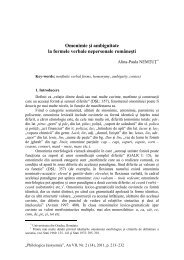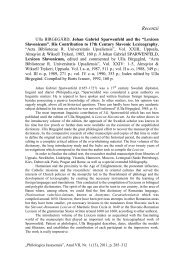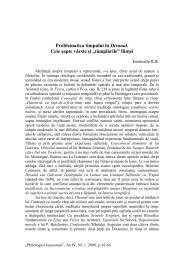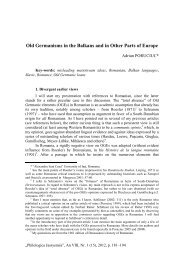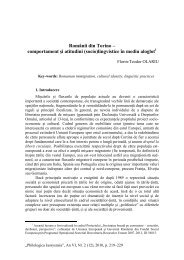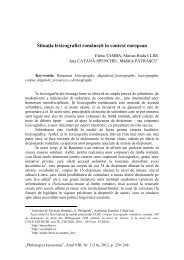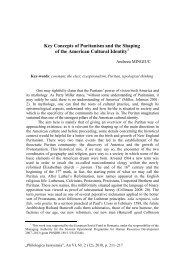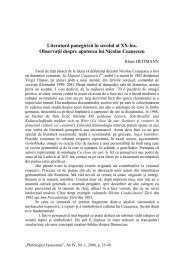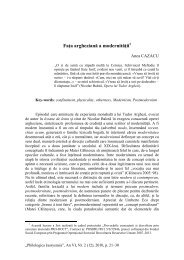Articol despre Stierle - Philologica Jassyensia
Articol despre Stierle - Philologica Jassyensia
Articol despre Stierle - Philologica Jassyensia
You also want an ePaper? Increase the reach of your titles
YUMPU automatically turns print PDFs into web optimized ePapers that Google loves.
Mihaela ALBU<br />
1.a. The Baragan – a Romanian Arcadia<br />
“Et in Arcadia ego!” – exclaims Odobescu in the beginning of his description<br />
of the Baragan plain, the space where the hunters can find their Paradise. The whole<br />
description is framed between that exclamation and a Gogolian expletive – “Damn<br />
you, plains, you are so beautiful!” (Odobescu 1990: 15). Recognizing that his<br />
description is almost a kind of translation of a fragment from Gogol’s Taras Bulba,<br />
the writer implicitly suggests the similarities between the Romanian Baragan and the<br />
Russian steppe.<br />
Odobescu, Calinescu and Fanus Neagu described the Baragan as an Arcadia,<br />
a rich territory in grain and also an attractive space. “Out of what Baragan really is,<br />
my flesh withholds […] the everlasting fragrance of the wheat”, confesses Fanus<br />
Neagu in the Postface of his book Under the Moonshine (Neagu 1979: 355). The<br />
wheat is the real richness of the Baragan, the wheat made this land famous; the<br />
wheat is “the human law, just the horse’s is the grass”, adds Fanus Neagu. “The<br />
world’s axle is passing through Baragan, because the beginning and the duration of<br />
all the worlds is getting through each and every wheat-ear stalk”, the writer<br />
continues metaphorically his confession.<br />
On the other hand, in his book of short stories – An Imaginary Kingdom –<br />
Stefan Banulescu describes “the yellow land with the abundance of corn; when the<br />
sun sets, daylight goes on because of the corn” (Banulescu 1997: 35). Both wheat and<br />
corn give the impression of an “immensity of the field’s solar tint”, and an isolated<br />
village seems to have “sun in the right, sun in the left”.<br />
The seasons influence the man’s life in the Baragan. His life is coordinated by<br />
the time of year. In summer, the plain gives to him the crop, the real purpose the<br />
countryman works the whole year. “In July, wheat is active in every action of life,<br />
including the memorial of the dead”. This is the Baragan, the plain whose “lung’s<br />
breath wheat” (Neagu 1979: 357).<br />
1.b. My village props its bone on the false acacia trees (Fanus Neagu)<br />
The Baragan, this “miraculous” plain, as many Romanian writers felt or<br />
wrote, this “edge of infinity”, this rich and poor territory, a strange mélange of<br />
wilderness and richness, where both hunter and peasant find their reason to live, can<br />
be branded through some specific plants. Besides the thistles, in this vast territory,<br />
where – in winter – the snow is abundant, and in summer the sun is shining so hard,<br />
the only tree that could resist to the aggressive weather is a species of the acacia, the<br />
false acacia. In the village of the Morometes “the place was full of acacias and of tall<br />
grass”. “A giant acacia … very leafy and tall” becomes an important part in the plot<br />
of the novel. Moromete, the peasant who tries to avoid paying taxes because he (as<br />
the majority of the others) has no money, cut the acacia and sold it: “as they had<br />
nothing else to sell, the acacia had to be cut down” (Preda 1957: 111), the narrator<br />
comments. It was “a some tough tree”, Moromete himself will notice later, sad and<br />
proud at the same time.<br />
The acacia had to be standing there, with its majestic height and its leafy<br />
crown like a sentinel above all that part of the village; now everything seemed to have<br />
10



